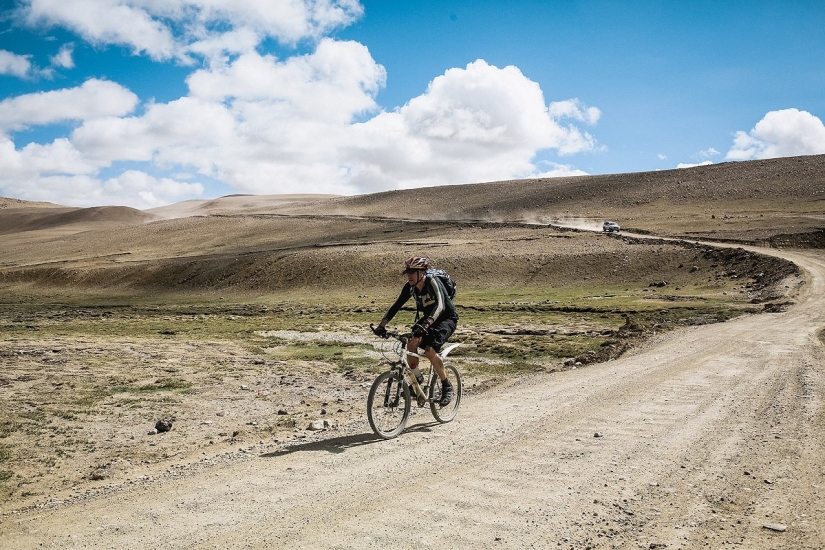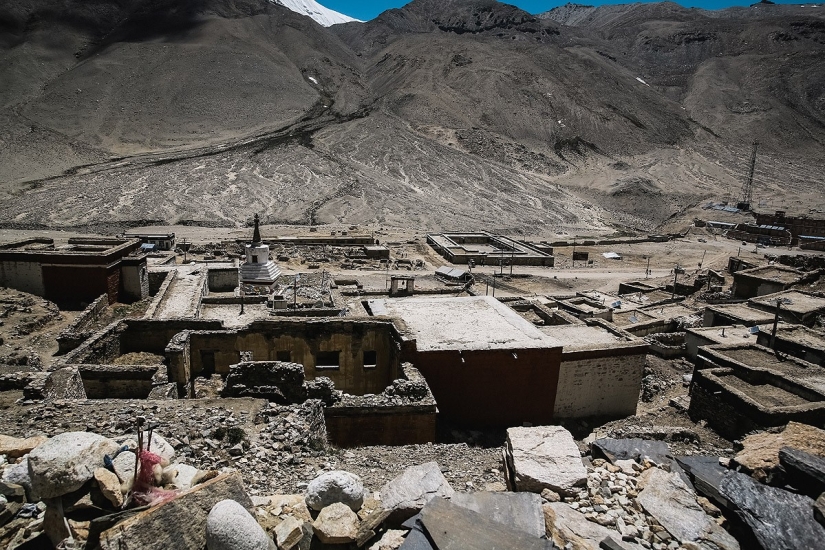In search of magic: at the foot of the Great Goddess
We continue our cycle of stories about the journey through the mysterious Tibet. This issue is dedicated to the foot of the Chomolungma, better known in the Western world as Everest - the highest place on Earth and the dream of every climber.

After the cave of the great yogi Milarepa, our path lay to the foot of Chomolungma.
Before the base camp, all travelers stop at Tingri, a small village at an altitude of 4390 meters, for further acclimatization. One street, 3-4 guesthouses. That's all.

1. View of our guesthouse. Water is already tight here, local girls carry it from the source, so all the dishes you will eat from are of dubious purity. But now this is the least of all, since constant headaches and a shrinking heart from such a height cause much more trouble.

2. From Tingri lies the road to Everest. Even two roads. One is 70 km, the other is 90. You can arrange trekking along a short path if you want to get to Everest on foot in 2-3 days. The second road can be reached by car in about four hours, because the road is very bad.

3. The only pet we saw (other than dogs).

4. One of the most active buyers of our team makes the last purchases, and go.

5. Pointer to Everest. The second name of the mountain is Chomolungma (it would be more correct in Tibetan to be Chomolangma, Radiant Mother - in honor of the Bon goddess Sherab Chzhamma). This is the highest point on earth. Height 8848 meters. You can only go higher by plane.

6. Also a pointer, only in Chinese characters, for lost tourists.

7. This is a walking road to the base camp.

8. During the walk, we met a French group of rather elderly people who went trekking with an escort car. They told us that they had taken medicine for altitude sickness before the trip, and felt quite well. They walked only with trekking sticks, everything else was carried by a car, but in our eyes they looked like real heroes, because it was difficult for us to walk even a few hundred meters.

9. People in Tingri always wear masks and this photo explains why. A cold dry wind with dust and small pebbles constantly blows from the mountains.

10. A small stupa on the way to Everest.

11. Prayer drums and a local version of the Tree of Life, which is set up for the New Year. Trees as such do not grow here, there are only shrubs.

12. Landscapes on the way to the camp. In addition to Everest, you can see four more eight-thousanders here: Shishapangma, Cho Oyu, Menlundze and Gauri Shankar.

13. A local resident stopped for meditation.

14. Small pass.

15. There are a lot of cyclists we saw along the way. Everyone travels with an escort car, but according to the law, foreigners cannot do otherwise. Chinese cyclists carry all things on a bicycle in special backpacks. This group consisted of people about 40 years old, among whom were women.

16. View of Everest. Base camp is getting closer!

17. Here we are. Height - about 5300 meters.

18. View from our room.

19. Our room for 4 people. As in Nyalam, there are several blankets on each bed, as it is cold at night. Toilet outside. Water flows in a thin stream from the tap on the street, enough to wash. But for tea it is better to take water in the dining room, in each guesthouse they give free thermoses with boiling water. A thermos is a very necessary thing in difficult climatic conditions.

20. Opposite the guesthouse, across the road, is the Rongbuk Monastery of the Nyingma school. The monastery is mixed, both monks and nuns live here. There are twenty people in total.

21. Stupas are ubiquitous in Tibet. Here they are called "chorten". They are not always as grandiose as, say, Swayambhu in Kathmandu. But this does not prevent them from fulfilling their function - to stabilize local energies and spread enlightened energies in the area.

22. Yak on the background of Everest. Now we have seen everything.

23. Newly arrived tourists from Australia, fascinated by the local beauty, went to look around in T-shirts, while we had already changed into full winter gear. The wind is icy, but the sun is very hot. Since the layer of air here is small, ultraviolet burns mercilessly. Eyes without goggles begin to hurt in just a minute.

24. Having examined the area, we went to the monastery for an evening puja, a ceremony with chants and playing various instruments.

25. At the end of the puja, the nuns invited us to taste the local tsampa.

26. The next day we covered the last four kilometers to the base camp. Tourists are not allowed further. This is the border with Nepal, and the passage is possible with special permits only for climbers.

27. Of course, we could not climb to the very top. But even near this tablet you understand what those who managed to visit on the very roof of the world feel.

28.

29. A small valley in front of Everest itself, climbers draw different pictures on it, which are clearly visible from the observation hill. This territory is already guarded by the military, as it is the border.

30. On the mountain near the end point of the tourist route there is such a dilapidated house. No one tells anything about him, but, as it turned out, this is one of the pearls of Tibet.

31. This is another cave. This time, the cave where the great Padmasambhava meditated, who brought Vajrayana Buddhism to Tibet, also known as Guru Rimpoche. It is called the "old" Rongbuk, this is the original location of the monastery where we went for puja. The distance between them is about 4 kilometers.

32.

33. Inside the "old" Rongbuk.

34. You need to go down the stairs to the cave.

35. It is almost as crowded here as in the cave of Milarepa. The energy of this place is indescribable.

36. But even here we sat down for 40 minutes to meditate.

37. Statue of Padmasambhava, the "owner" of the cave.

38. The caretaker of the cave, who spent 20 years of his life here.

39. In the base camp you can buy traditional souvenirs. Moreover, here is the highest post office in China, and, perhaps, in the whole world. Tourists are happy to send postcards with views of Everest to friends and themselves. We also sent ourselves a postcard. They all arrived within a month.

40. A typical set of Tibetan souvenirs - dzi stones, melong mirrors, yak bone pendants, rosaries, etc.

41. Since the Tibetan Plateau was once the bottom of the ocean, these fossils are found here.

42.

43. In the evening we looked at the monastery "from the yard", that is, we climbed up the slope above it. There were many green flags and old tattered clothes. As it turned out, this is a "cemetery", or, more precisely, a place where the belongings of the dead are left. The bodies themselves, in accordance with the Tibetan tradition, are chopped up and fed to the birds.

44. In the morning we set off for Shigatse, once again capturing the fabulous snowy peaks in our cameras and in our memory. View from a height of almost 6000 m, which climbed two of our strongest members of the group.

45. Lalung-la pass, the height of the pass is written on the house.

46. As always, there are a lot of flags here.

47. And a bunch of Tibetans offering to buy these flags and hang them yourself.

48. Here, if you wish, you can smoke “sang”, a mixture of juniper and other plants, in a special stove.

49. Gradually the mountains became not so high.

50. Soon we went to the plain. Ahead of us was Shigatse, the second largest city in Tibet after Lhasa.
Photo: Ekaterina Ageeva / Text: Sergey Martynov
Keywords: In search of magic | Tibet | Everest
Post News ArticleRecent articles

Any journey is fraught with many discoveries and observations, of which over time can form a whole collection. Today you will see ...

Life with Pets is always fun. Why are only their daily funny antics, which make us laugh to tears, and love them even more. The ...
Related articles

We all know that decomposition is a natural process that no living being can avoid after death. You can stop it with the help of ...

Everest, the highest mountain on the planet, became now the most high-rise garbage, and the problem is compounded. The number of ...

In just five years and three and a half billion dollars, China built a 1,150-kilometer highway connecting the "Roof of the World" ...

This is another post dedicated to optical illusions, as many of us are interested in this topic. Optical illusions are created by ...